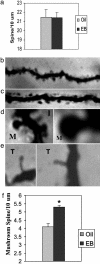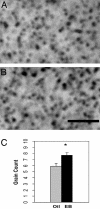Estrogen alters hippocampal dendritic spine shape and enhances synaptic protein immunoreactivity and spatial memory in female mice
- PMID: 14766964
- PMCID: PMC357073
- DOI: 10.1073/pnas.0307313101
Estrogen alters hippocampal dendritic spine shape and enhances synaptic protein immunoreactivity and spatial memory in female mice
Abstract
Estrogen (E) treatment induces axospinous synapses in rat hippocampus in vivo and in cultured hippocampal neurons in vitro. To better explore the molecular mechanisms underlying this phenomenon, we have established a mouse model for E action in the hippocampus by using Golgi impregnation to examine hippocampal dendritic spine morphology, radioimmunocytochemistry (RICC) and silver-enhanced immunocytochemistry to examine expression levels of synaptic protein markers, and hippocampal-dependent object-placement memory as a behavioral readout for the actions of E. In ovariectomized mice of several strains and F(1) hybrids, the total dendritic spine density on neurons in the CA1 region was not enhanced by E treatment, a finding that differs from that in the female rat. E treatment of ovariectomized C57BL/6J mice, however, caused an increase in the number of spines with mushroom shapes. By RICC and silver-enhanced immunocytochemistry, we found that the immunoreactivity of postsynaptic markers (PSD95 and spinophilin) and a presynaptic marker (syntaxin) were enhanced by E treatment throughout all fields of the dorsal hippocampus. In the object-placement tests, E treatment enhanced performance of object placement, a spatial episodic memory task. Taken together, the morphology and RICC results suggest a previously uncharacterized role of E in synaptic structural plasticity that may be interpreted as a facilitation of the spine-maturation process and may be associated with enhancement of hippocampal-dependent memory.
Figures






Similar articles
-
Estradiol increases pre- and post-synaptic proteins in the CA1 region of the hippocampus in female rhesus macaques (Macaca mulatta).Endocrinology. 2003 Nov;144(11):4734-8. doi: 10.1210/en.2003-0216. Epub 2003 Aug 13. Endocrinology. 2003. PMID: 12960039
-
Novel target sites for estrogen action in the dorsal hippocampus: an examination of synaptic proteins.Endocrinology. 2001 Mar;142(3):1284-9. doi: 10.1210/endo.142.3.8036. Endocrinology. 2001. PMID: 11181546
-
Estrogen increases the number of spinophilin-immunoreactive spines in the hippocampus of young and aged female rhesus monkeys.J Comp Neurol. 2003 Oct 27;465(4):540-50. doi: 10.1002/cne.10837. J Comp Neurol. 2003. PMID: 12975814
-
The opposing roles of estradiol on synaptic protein expression in hippocampal cultures.Psychoneuroendocrinology. 2009 Dec;34 Suppl 1:S123-9. doi: 10.1016/j.psyneuen.2009.08.013. Psychoneuroendocrinology. 2009. PMID: 19781860 Review.
-
Direct and indirect effects of estrogen on rat hippocampus.Neuroscience. 2006;138(3):765-72. doi: 10.1016/j.neuroscience.2005.05.061. Epub 2005 Dec 1. Neuroscience. 2006. PMID: 16324798 Review.
Cited by
-
Effects of estrogen on spatial navigation and memory.Psychopharmacology (Berl). 2024 May;241(5):1037-1063. doi: 10.1007/s00213-024-06539-3. Epub 2024 Feb 26. Psychopharmacology (Berl). 2024. PMID: 38407638 Free PMC article. Clinical Trial.
-
Estradiol and ERβ agonists enhance recognition memory, and DPN, an ERβ agonist, alters brain monoamines.Neurobiol Learn Mem. 2010 Nov;94(4):488-98. doi: 10.1016/j.nlm.2010.08.016. Epub 2010 Sep 7. Neurobiol Learn Mem. 2010. PMID: 20828630 Free PMC article.
-
Chemogenetic inactivation of the dorsal hippocampus and medial prefrontal cortex, individually and concurrently, impairs object recognition and spatial memory consolidation in female mice.Neurobiol Learn Mem. 2018 Dec;156:103-116. doi: 10.1016/j.nlm.2018.11.002. Epub 2018 Nov 5. Neurobiol Learn Mem. 2018. PMID: 30408525 Free PMC article.
-
Sex steroid hormones regulate the expression of growth-associated protein 43, microtubule-associated protein 2, synapsin 1 and actin in the ventromedial nucleus of the hypothalamus.J Mol Neurosci. 2012 Mar;46(3):622-30. doi: 10.1007/s12031-011-9650-z. Epub 2011 Sep 27. J Mol Neurosci. 2012. PMID: 21948316
-
Postmenopausal hormone treatment alters neural pathways but does not improve verbal cognitive function.Menopause. 2018 Dec;25(12):1424-1431. doi: 10.1097/GME.0000000000001157. Menopause. 2018. PMID: 29994967 Free PMC article.
References
Publication types
MeSH terms
Substances
Grants and funding
LinkOut - more resources
Full Text Sources
Medical
Miscellaneous

